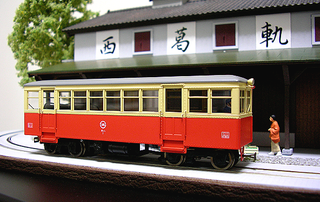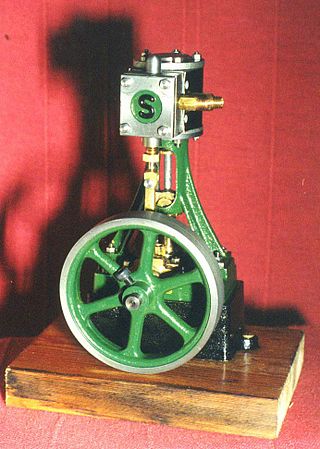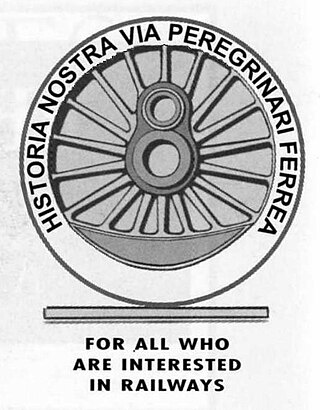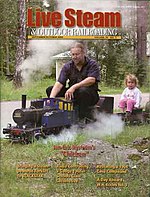
Railway modelling or model railroading is a hobby in which rail transport systems are modelled at a reduced scale.
Bassett-Lowke was an English toy manufacturing company based in Northampton. Founded by Wenman Joseph Bassett-Lowke in 1898 or 1899, the company specialized in model railways, boats and ships, and construction sets. Bassett-Lowke started as a mail-order business, although it designed and manufactured some items.

Railroad Model Craftsman is an American magazine specializing in the hobby of model railroading. The magazine is published monthly by White River Productions, which acquired the title from Carstens Publications in 2014. Its first issue in March 1933 was called The Model Craftsman because it covered other areas of scale modeling as well. Founded by Emanuele Stieri, it was second editor Charles A. Penn who helped grow the company and lead the publication towards the hobby of scale models. In April 1949 it changed its focus to model trains and changed its name to Railroad Model Craftsman to reflect this change in editorial content. While it can claim to be the oldest model railroading magazine in continuous publication in the United States, rival Model Railroader counters with the tagline "Model railroading exclusively since 1934." Over the years, several other titles have been folded into the publication, including Toy Trains, Electric Trains and Hobby Railroading, Miniature Rail Roading, Model & Railway News, and The O Gager.

Model engineering is the pursuit of constructing proportionally-scaled miniature working representations of full-sized machines. It is a branch of metalworking with a strong emphasis on artisanry, as opposed to mass production. While now mainly a hobby, in the past it also had commercial and industrial purpose. The term 'model engineering' was in use by 1888. In the United States, the term 'home shop machinist' is often used instead, although arguably the scope of this term is broader.

The Carolwood Pacific Railroad (CPRR) was a 7+1⁄4-inch gauge ridable miniature railroad run by Walt Disney in the backyard of his home in the Holmby Hills neighborhood of Los Angeles, California. It featured the Lilly Belle, a 1:8-scale live steam locomotive named after Disney's wife, Lillian Disney, and built by the Walt Disney Studios' machine shop. The locomotive made its first test run on December 24, 1949. It pulled a set of freight cars, as well as a caboose that was almost entirely built by Disney himself. It was Disney's lifelong fascination with trains, as well as his interest in miniature models, that led to the creation of the CPRR. The railroad, which became operational in 1950, was 2,615 feet (797 m) long and encircled his house. The backyard railroad attracted visitors to Disney's home; he invited them to ride and occasionally drive his miniature train. In 1953, after an accident occurred in which a guest was injured, the CPRR was closed to the public.

The Disneyland Railroad (DRR), formerly known as the Santa Fe & Disneyland Railroad, is a 3-foot narrow-gauge heritage railroad and attraction in the Disneyland theme park of the Disneyland Resort in Anaheim, California, in the United States. Its route is 1.2 miles (1.9 km) long and encircles the majority of the park, with train stations in four different park areas. The rail line, which was constructed by WED Enterprises, operates with two steam locomotives built by WED and three historic steam locomotives originally built by Baldwin Locomotive Works. The ride takes roughly 18 minutes to complete a round trip on its main line when three trains are running, and 20 minutes when four trains are running. Two to four trains can be in operation at any time, three on average.

A garden railroad or garden railway is a model railway system set up outdoors in a garden. While G is the most popular scale for garden railroads, 16 mm scale has a dedicated and growing following especially in the UK. Model locomotives in this scale are often live steam scale models of British narrow gauge prototypes. 16 mm scale track, the same gauge as O gauge is probably now more popular in the UK than G scale.

Live steam is steam under pressure, obtained by heating water in a boiler. The steam may be used to operate stationary or moving equipment.

A backyard railroad is a privately owned, outdoor railroad, most often in miniature, but large enough for one or several persons to ride on. The rail gauge can be anything from 2+1⁄2 in to 7+1⁄2 in or more. Smaller backyard or outdoor railroads that cannot be ridden are called garden railroads. Some backyard railroads use full-size rolling stock, such as the former 3 ft narrow gauge Grizzly Flats Railroad owned by railfan and Disney animator Ward Kimball.

The Redwood Valley Railway is a 15 in gauge miniature railway in Tilden Regional Park near Berkeley, California.
William Jones (1884–1968), a seasoned veteran of the steam era who established the Wildcat Railroad in Los Gatos, California, was born the son of a teamster in the town of Ben Lomond, California, USA.

The Australian Railway Historical Society (ARHS) aims to foster an interest in the railways, and record and preserve many facets of railway operations. It had divisions in every state and the Australian Capital Territory, although the ACT division was wound up in 2016, along with the Victorian division in 2020. Since 1967, when each division incorporated, the state divisions have operated as separate entities. Each still trades under the ARHS brand, except in Western Australia, where the division is called Rail Heritage WA. Individual membership exceeds 2,500.

A ridable miniature railway is a large scale, usually ground-level railway that hauls passengers using locomotives that are often models of full-sized railway locomotives.

Minimum-gauge railways have a gauge of most commonly 15 in, 400 mm, 16 in, 18 in, 19 in, 500 mm or 20 in. The notion of minimum-gauge railways was originally developed by estate railways and the French company of Decauville for light railways, trench railways, mining, and farming applications.

Garden Railways (GR) was a quarterly American magazine about the hobby of running large-scale trains outdoors, also called garden railroading. During its run, it was the world's leading magazine on that subject. Each issue featured hobby news, product reviews, how-to articles, featured railroads from around the world, photo galleries, and much more. Publication ceased after the Fall 2020 issue.

The Grizzly Flats Railroad (GFRR) was a 3-foot narrow-gauge heritage railroad owned by Disney animator Ward Kimball at his home in San Gabriel, California. The railroad had 900 feet (274.3 m) of track, and was operated from 1942 to 2006. It was the first full-size backyard railroad in the United States.
Interurban Press was a small, privately owned American publishing company, specializing in books about streetcars, other forms of rail transit and railroads in North America, from 1943 until 1993. It was based in the Los Angeles area, and specifically in Glendale, California after 1976. Although its primary focus was on books, it also published three magazines starting in the 1980s, along with videos and calendars. At its peak, the company employed 10 people and generated about $2 million in business annually.

Railfan & Railroad is an American monthly magazine that has been in publication since the 1970s. It was the first magazine title established in-house by Carstens Publications. As a magazine dedicated to trains and rail transportation, it stands out from its main competitor Trains as a publication focused on the enthusiast and related activities. Established in 1974 as Railfan magazine, it merged in 1979 with Railroad magazine, which Carstens purchased at that time. The magazine was renamed Railfan & Railroad, but the two former titles were listed separately on the masthead until 2015. The magazine was acquired by White River Productions in September 2014. The magazine is produced monthly, edited by Steve Barry.
David C. Curwen was an English miniature railway steam locomotive mechanical engineer.
White River Productions is an independent publishing company that specializes in books and magazines targeted to railroad enthusiasts and historians. Kevin EuDaly founded the company in 1992 to published the book Missouri Pacific Diesel Power, which he also authored. Several other titles followed, and the company became his full-time venture beginning in 1996. The company expanded when it took on publishing newsletters and managing membership databases for several railroad historical societies. The company is headquartered in Bucklin, Missouri.















